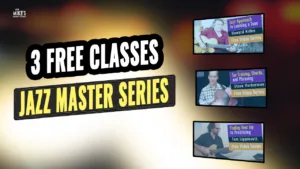Mastering the basic major, minor, diminished, and augmented triads is widely acknowledged as a crucial step in the development of any jazz musician. This is particularly important on an instrument like guitar which can be played both melodically and harmonically.
Triads form the basic building blocks of more complex harmonies as well as the upper part of these chords.
In this series of classes, we will systematically examine all of the traditional triads that are diatonic to the major, melodic minor, and harmonic minor scales and find many unique and creative uses for them, both for chords and for single-note lines. But the fun doesn’t stop at traditional triads; in this five-part class, we will also explore all of the three-note chords that are possible in the above three scales. This includes suspended triads, seventh chords with no fifth, seventh chords with no third, and clusters.
By practicing these five structures, guitarists can add many fresh and exciting sounds to their music. One advantage of three-note chords is that they tend to be easier to play and more “portable” than bigger four-, five-, and six-note chords. These shapes work exceptionally well for both comping and for supporting a melodic line with harmony.
Arpeggios built from this variety of three-note chords can also generate some interesting new melodic ideas.
In the first class, we will explore traditional triads, the roots of the harmonic tree. A command of these structures will be necessary in order to facilitate the exploration of the more exotic sounds in the subsequent classes.
Guitarists who have been through my Jazz Guitar Harmony part 2 and Jazz Guitar Harmony part 3 and absorbed the material on triads may find this class unnecessary. However, there are a few new concepts in this class that aren’t covered in the Jazz Guitar Harmony series.
Diatonic Triads Complete part 1: Traditional Triads covers:
- review of the theoretical basis of triads
- “piano style” versus “choir style” inversion on the guitar
- map of all inversions of major triads
- explanation of the concept of diatonic triads, with example exercises
- using diatonic cycles to gain fluency with inversions and voice leading
- exploration of open triads
- applying diatonic cycles of open and close triads to the melodic and harmonic minor scales
- examples of single note musical phrases incorporating all of the above
- using triads to harmonize a melodic line
- 59 minute running time
- includes 10 pages of written examples and exercises
- includes backing track for II V I musical example
- All musical examples from the video are provided in music notation, tablature, and chord grid form.
- Each example performance is shown in close-up view and titled and numbered for easy navigation.














Very Good
A very good introduction and/or review of triads with some unique and challenging information. Thanks Tom.
by Gary TorkeoDiatonic Triads Complete, Parts I-V
Congratulations Tom on the excellent Diatonic Triads Complete series of courses. Along with listening and rhythm, triads, arpeggios and harmonized scales form the basis of my understanding of music. From the previews to this five part course I could tell, now was the time to acquire the package and Tom would expand my knowledge. As with all his courses, Tom’s sound quality and presentation have resulted in a learning experience that will require years of practice, yet after just the first day on Part I, I am already challenged into new ways of thinking about the basic concepts that I can immediately apply to my playing. Thank you Tom, looking forward to the work.
by Blair HunterThis is the first class I’ve taken by Tom and it was excellent. Very thorough and well laid out with great sounding musical examples. If you’re not yet solid on all your triads up and down the neck, this would be a great place to get started. He really packed a ton of information into this short course.
Looking forward to checking out more of Tom’s material soon.
by Joseph HandyDiatonic Triads pt.1
Another great class from Tom. Knowing how methodical and thorough Tom’s teaching style is, I clearly found this was more than just a review of triads; it is the necessary base for the Good Stuff to come. That being said, this class has a lot of great material in and of itself. 5 stars is the minimum for this whole series.
by james seaberry